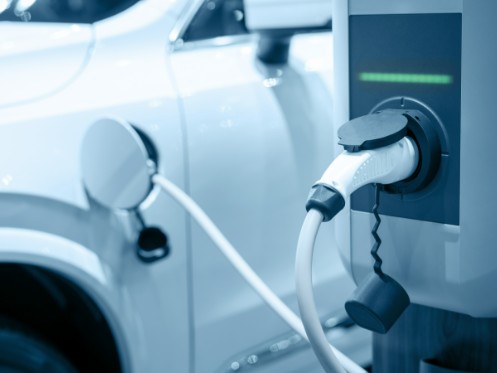If you have an electric or hybrid vehicle, you must consider how and where you charge it. The type of charging station you use can have a major impact on the life and health of your EV battery. In this guide, we’ll explain all you need to know about the different EV charging stations and why installing a Level 2 charging station at your home is an intelligent investment.
Types of EV Charging Stations and the Effect They Have on EV Batteries
There are three types of EV charging stations. Which one you normally use can have a major effect on your vehicle’s battery life. Some can cause the battery to degrade more quickly. If your EV battery starts to degrade, your vehicle’s range will also decrease.
Level 1 charging is the slowest option, just plugging your EV into a standard 120-volt outlet. With Level 1 charging, it will normally take 20 to 40 hours or more to fully charge your battery if it’s mostly empty. This means that Level 1 charging isn’t all that practical unless you normally don’t drive that many miles per day.
Level 2 charging stations operate on a 240-volt circuit and are generally the most practical option for home use. If you install a Level 2 charger in your garage or outside your home, you can fully charge your vehicle overnight. Depending on the ambient temperature and the range of your vehicle, it will take a Level 2 station somewhere between four and 10 hours to charge a mostly empty battery.
Level 3 DC fast charging is what you’ll find at most public charging stations. This station type can give you a full charge in under an hour. One difference between the different charging levels is that Level 1 and 2 stations don’t directly charge your battery. All EVs have an internal charger, and Level 1 and 2 stations simply supply AC power to the internal charger so that it can then send DC power to charge the battery. Level 3 stations are different, as they bypass the internal charger and send DC power directly to the battery.
Level 3 stations are great for road trips or if your battery starts running low and you don’t have enough range to make it home. However, it’s better for your battery if it charges more slowly. Charging the battery more quickly generates more heat, leading to the battery degrading over time. If you frequently use a Level 3 station, your battery will likely not last nearly as long. Unless you’re on a road trip and have no other options, most experts recommend never using Level 3 charging more than three or four times a month.
How the Internal Charger Regulates the Charging Rate
Level 1 charging is technically the best option for protecting your EV battery since it charges much more slowly. We say “technically” because an EV’s internal charger can adjust the charging rate to prevent the battery from charging too quickly. It does this automatically based on how much charge the battery currently has.
When the battery is mostly empty, the charger will charge it faster but not so fast that it could damage the battery. The charging rate will greatly decrease as the battery starts nearing 80% charge. This is important to prevent the battery from being damaged.
When the cells in the battery are fuller, the charger has to work harder since the cells have less space for the energy to be stored. If the battery were to continue charging faster when the cells were mostly full, it would quickly start to heat up and potentially suffer damage.
Why You Should Only Charge Your EV to 80%
Most manufacturers recommend that you normally only charge your EV battery to 80%, and most EVs have a setting that allows you to set what percentage you want the battery to charge to. Even though the rate of charging decreases as the battery nears 80% complete, constantly charging it to 100% puts much more strain on it. This can cause it to degrade more quickly and shorten its lifespan.
Charging your battery to 100% occasionally isn’t that big of an issue. It is sometimes necessary if you have a long trip ahead of you. That said, the lithium-ion batteries in EVs work most efficiently when they have between 20% and 80% charge.
Another thing to consider is that it typically takes an extremely long time for a battery to charge to 100% since the rate of charging decreases the fuller the cells get. In fact, it typically takes just as much time to charge a battery from 80% to 100% as it does from empty to 80%.
Why It’s Best to Charge Your EV Inside
If possible, you’re always better off charging your EV inside a temperature-controlled environment or somewhere that isn’t extremely hot or cold. Charging your battery in extremely hot or cold temperatures will cause it to degrade much more quickly. Ideally, you should always charge your battery in an area between 50- and 85-degrees Fahrenheit. This will lessen the strain on the battery and help prevent it from degrading.
Another reason is that batteries charge much more slowly in colder temperatures. If you charge your vehicle outside during the winter, you won’t receive nearly as much range in the same time as you would if you charged it in your garage, where it’s warmer. The fact that batteries charge more slowly in colder temperatures means that the internal charger will reduce the amount of current that it sends to the battery to prevent it from being damaged.
Benefits of Installing a Level 2 EV Charging Station at Your Home
Having a Level 2 EV charging station at your home can make your life much more convenient and help save you money. Not only does Level 3 charging cause your battery to degrade more quickly, but most Level 3 stations are also fairly expensive. They charge anywhere from $0.35 to $0.60 per kilowatt-hour (kWh) of electricity. The average electricity rate in Oregon is only around $0.15 per kWh, which shows how much cheaper it is to charge your EV at home.
If you only need to drive a few miles between charges, you’re generally fine just using Level 1 charging. However, if you take a road trip, you would need to leave your vehicle plugged in for nearly two full days to get back to a full charge. This makes a Level 2 station a great investment, as it will allow you to plug in your vehicle overnight and always ensure you have a full charge in the morning. If your family has two EVs, you could even charge both of them daily by plugging one in when you get home and switching to the other before you head to bed.
Another thing to consider is that many electricity providers charge higher rates per kWh at the peak times of the day. With a Level 2 station, you can save money by setting the charger to start charging your vehicle at off-peak times when electricity rates are lower.
The expert electricians at 3 Mountains Home Services are ready to help install an EV charging station at your home. We also provide a full range of other electrical installations and repair services for customers in the Milwaukie, OR area. As a full-service provider, you can turn to us for all your plumbing, drain, and sewer needs. To schedule a consultation and learn more about your options for EV charger installation, give us a call today.


